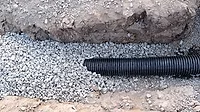Alfresco Shower
Julius Ballanco
Being out of the loop, it surprised me to learn that the latest trend in plumbing is alfresco showers.
If you are wondering what an alfresco shower is, it is a fancy name for an outside shower. Outside showers, of course, are not new. I remember as a kid taking an outside shower at a beach house in New Jersey.
Today, outside showers are popular at many beach resorts. As you leave the beach, there is a shower and foot wash available to wash the sand, saltwater and lotion off the body.
Back To Nature
But the alfresco shower takes the outside shower concept one step further. The alfresco shower is where you take the normal morning (or evening) shower. Rather than going to the bathroom to shower, you go outside to the alfresco shower. That way, you can bond with nature as you refresh yourself.As I was reading about this wonderful new trend, many plumbing questions started to pop into my head. My first thought was that around October, it starts to get real cold in Chicago.
All right, many parts of the country can go much further into the year before the temperature drops. Some areas, like Miami, never experience freezing temperatures. But, the alfresco shower is considered a trendy fixture for the cold as well as the warmer climates.
If we consider the alfresco shower a seasonal shower, there needs to be a way to address the plumbing connections. It is no surprise that water freezes on the outside. So there must be some means of protecting the water lines. The question becomes, should that be an automatic means or simply a manual means of protection?
Better yet, should the water lines have a heat tracing system for those hearty individuals that want to shower outside in the snow?
The water tends to be an easy problem to solve. If I were going to go to the expense of an outdoor shower, I would prefer to have an automatic draining system. How, you might ask? Rather than a complex system, I envision two automatic, three-way valves — one on the hot, one on the cold. Then, as you enter the shower, I would have a push button that activates the three-way valves for a period of time, say, 30 minutes.
At the high point of the piping system, I would put in automatic air release valves. That way, when the push button turns on the water, all of the air is bled out of the line. When the three-way valve turns the supply line to drain, the air enters the piping system, allowing the water to drain.
The only difficulty would be draining the water in the shower riser. Someone would have to turn the shower valve on to drain the line. Or you could simply put a tub filler with a diverter in to serve as the drain when the shower is turned off.
Of course, the manual system could be a couple of stop and waste valves located on the inside of the building. But now you are relying on a homeowner to know how to use a stop and waste valve. We decided not to rely on that when we developed frost-proof sillcocks.
Where To Drain?
The more difficult problem is the drain. You could take the simplistic viewpoint and say that there doesn’t have to be a drain, the water will just flow into the yard. After all, this is how they have installed the beach showers.However, the beach showers are rinsing off the sand; an alfresco shower is a standard shower with soap, shampoo and cream rinses, to name a few. In many parts of the country, you cannot take that wastewater and discharge it on grade.
If you can discharge the shower wastewater to grade in your jurisdiction, fine. You have nothing to worry about. For those unable to discharge to grade, the drain becomes a real problem.
First problem is that the majority of these alfresco showers have no roof. Thus, when it rains, the rainwater runs down a sanitary drain. Unless there is a combined sewer, storm water is not permitted to drain into a sanitary drainage system.
If the shower has a threshold around the base, you may be able to convince the local inspector that only a minimal amount of rainwater would ever enter the system. Otherwise, you would have to arrange for a means of closing off the drain when it is not in use, or the shower would have to have a roof.
The other problem would be the trap. Again, in cold climates, the trap could freeze. One option would be to bury the trap below the frost line. However, in Chicago, that would mean a trap that is 4 feet in the ground, and even that may not be enough. Plus, the plumbing codes only allow the trap to be located 2 feet below the base of the shower.
The options appear to be either heat tracing or anti-freeze in the trap each winter. One other alternative could be the installation of a French drain. Have a large enough area below grade, filled with rocks, covered with a polyethylene sheet, finished with ground cover, grass or landscaping. The shower drain then discharges to a grey water drainage system without the need for a trap.
While we are at it, the vent adds the final twist to the alfresco shower. For the vent, I wouldn’t screw around. The alfresco shower is an ideal location for an air admittance valve. It can be low, hidden away, while protecting any trap seal.
Looking for a reprint of this article?
From high-res PDFs to custom plaques, order your copy today!






